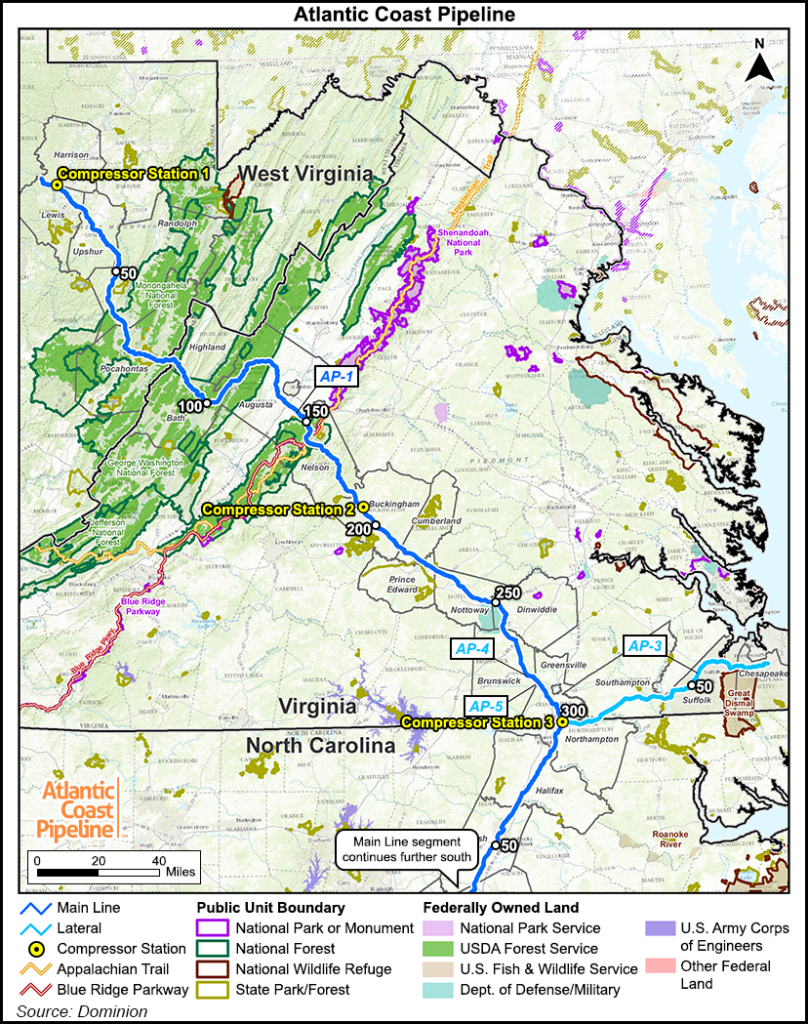Regulatory | Infrastructure | NGI All News Access
Forest Service ‘Concerned’ About Erosion From Atlantic Coast, Mountain Valley Pipelines
The U.S. Forest Service (USFS) said it “is concerned” that two proposed Appalachia-to-Southeast natural gas pipelines would traverse steep slopes subject to erosion, and it has asked its backers to submit additional information as it considers issuing special use permits for the projects.

In separate letters filed Monday with FERC, forest supervisors Clyde Thompson and Joby Timm outlined nearly identical concerns to Atlantic Coast Pipeline LLC (ACP) and Mountain Valley Pipeline LLC (MVP).
The proposed pipeline routes, the forest managers wrote, “would cross some very challenging terrain in the central Appalachians. Potentially difficult situations include steep slopes, presence of headwater streams, geologic formations with high slippage potential, highly erodible soils, and the presence of high-value natural resources downslope of high-hazard areas.
“These hazards are exacerbated by high annual rates of precipitation and the potential for extreme precipitation events. Similar hazards on other smaller pipeline projects in the central Appalachians have led to slope failures, erosion and sedimentation incidents, and damage to aquatic resources. Therefore, USFS is concerned that crossing such challenging terrain with a much larger pipeline could present a high risk of failures that lead to resource damage.”
USFS told the Federal Energy Regulatory Commission that the ACP would affect 21.2 miles of national forest lands, traversing parts of the Monongahela and George Washington national forest [CP15-554]. Meanwhile, the MVP would affect 3.4 miles of the Jefferson National Forest [CP16-10].
Thompson acknowledged in his letter that ACP “has proposed implementing ‘best in class’ slope stabilization and erosion/sedimentation control measures,” and has provided general descriptions and conceptual drawings in other filings. He said USFS had asked ACP to provide information on how effective the company’s techniques have been elsewhere.
“To further clarify the likelihood that the ACP can be constructed through the George Washington and Monongahela National Forests without undue risk of resource damage, the USFS is requesting that ACP develop site-specific stabilization designs for selected areas of challenging terrain,” Thompson said. He added that USFS staff had identified 10 areas — six in the George Washington National Forest and four in the Monongahela National Forest — that “appear to present a high risk for slope failure, slippage, and erosion/sedimentation.”
In his letter, Timm said MVP has also proposed methods to stabilize slopes and to mitigate erosion and sedimentation issues. Like the ACP project, Timm said USFS wanted to know how well MVP’s methods worked elsewhere. He said USFS staff had identified six potential problem areas in the Jefferson National Forest.

Timm added that USFS “expects MVP to submit an amended Special Use Permit application to address USFS’s previous comments on the proposed MVP project route.” Thompson did not make a similar statement in his letter to ACP.
Last May, USFS told FERC that MVP’s current plan to cross the Appalachian National Scenic Trail was “inadequate” and said the company should reconsider its plan for the crossing (see Daily GPI, May 17).
ACP and MVP each submitted applications with FERC last fall and have similar aspirations to connect producing areas in the Appalachian Basin to markets in the Southeast and Mid-Atlantic (see Daily GPI, Oct. 23, 2015; Sept. 18, 2015). Both are targeting in-service dates in late 2018.
The 1.5 Bcf/d, 600-mile ACP is backed by Dominion, Duke Energy, Piedmont Natural Gas and AGL Resources. The 2 million Dth/d, 301-mile MVP is a joint venture between EQT Midstream Partners LP, NextEra US Gas Assets LLC, Con Edison Gas Midstream LLC, WGL Midstream, Vega Midstream MVP LLC and RGC Midstream LLC.
© 2024 Natural Gas Intelligence. All rights reserved.
ISSN © 1532-1231 | ISSN © 2577-9877 |
